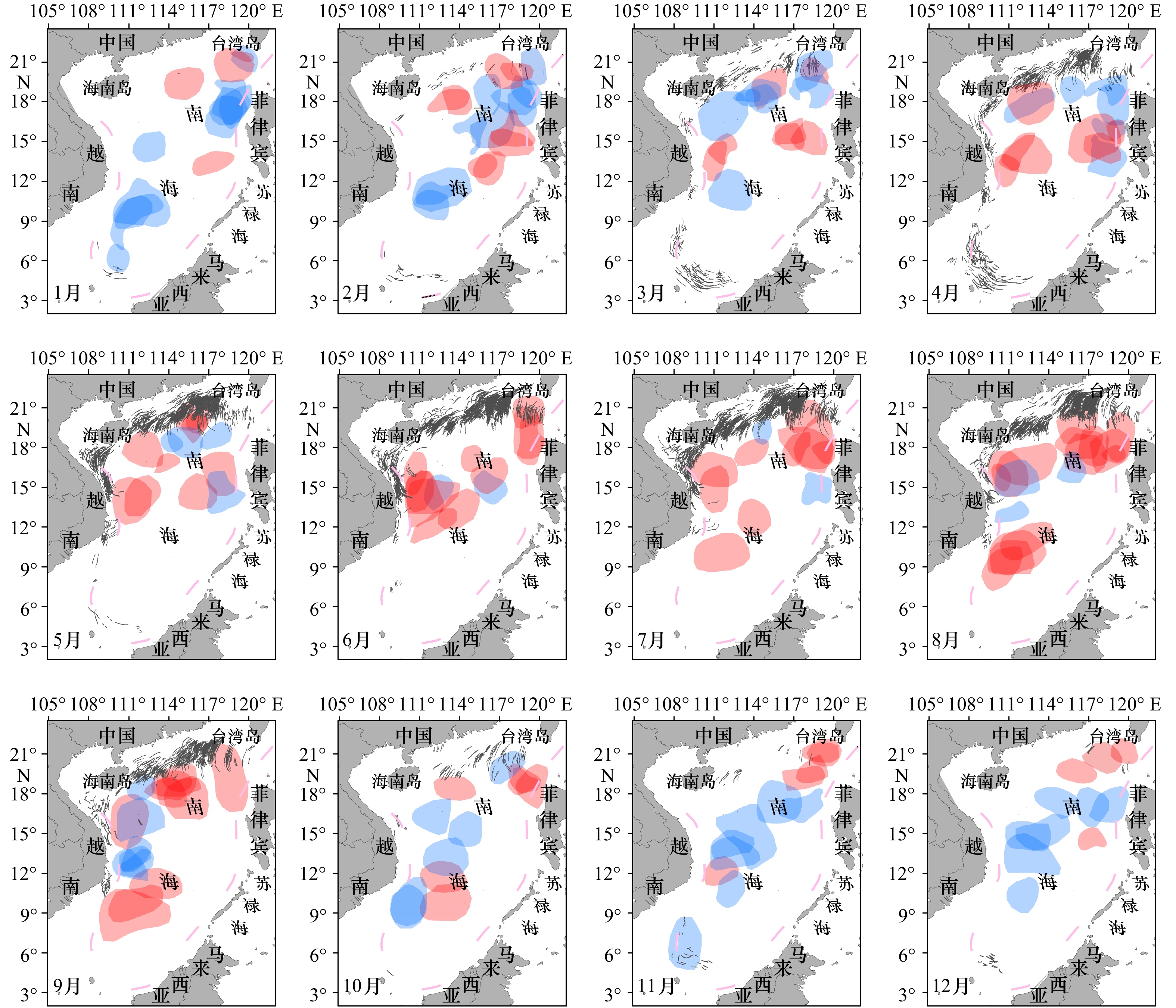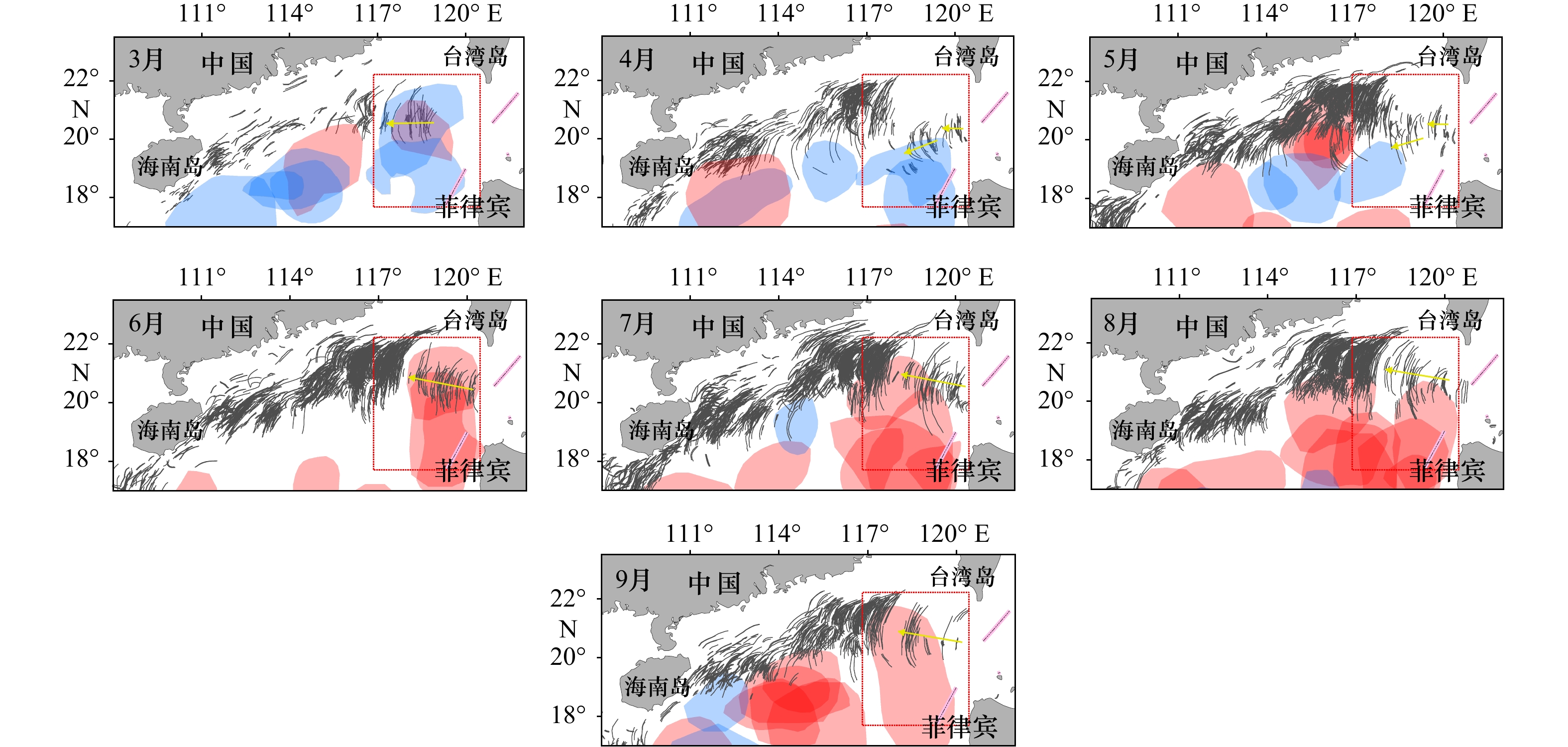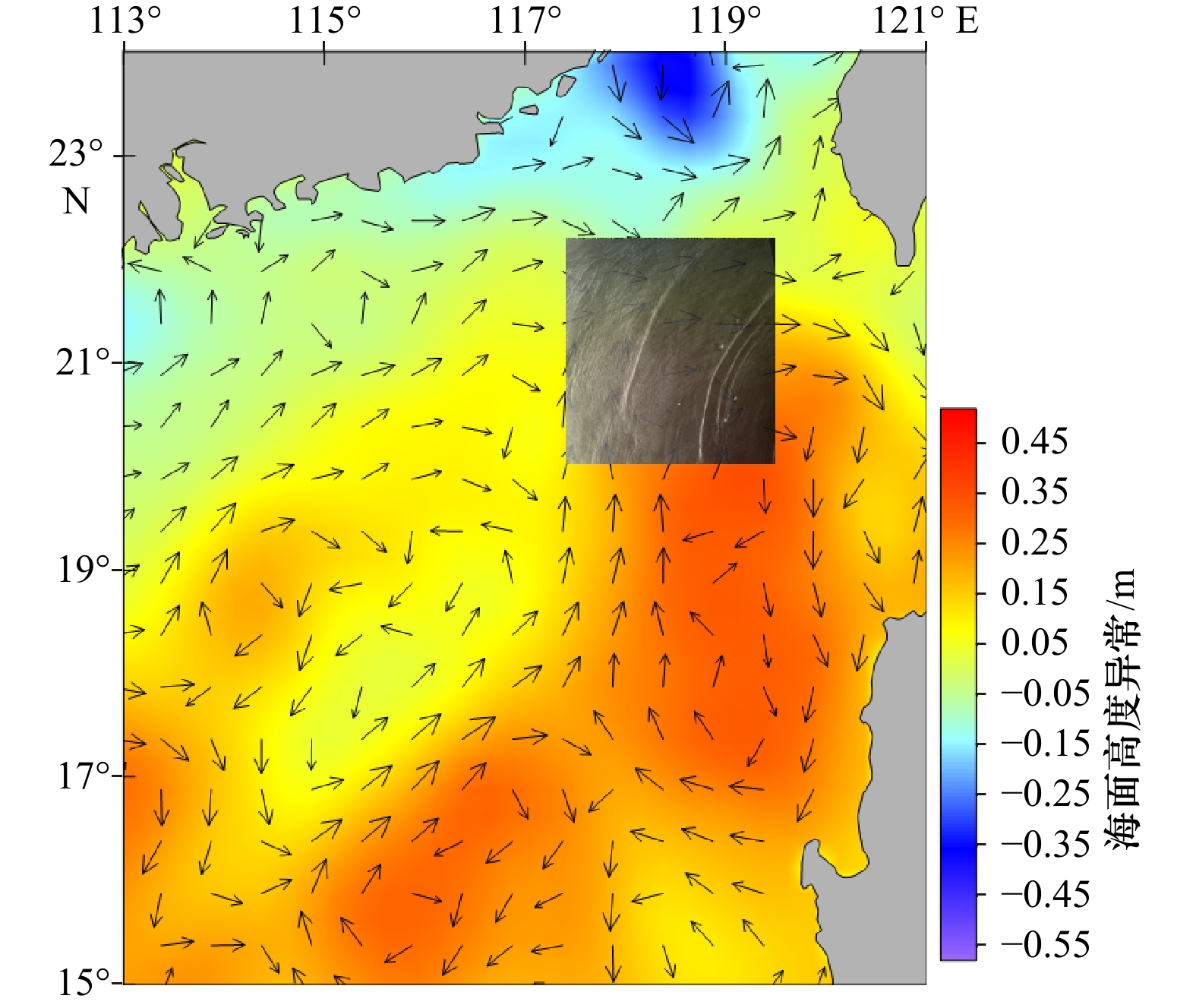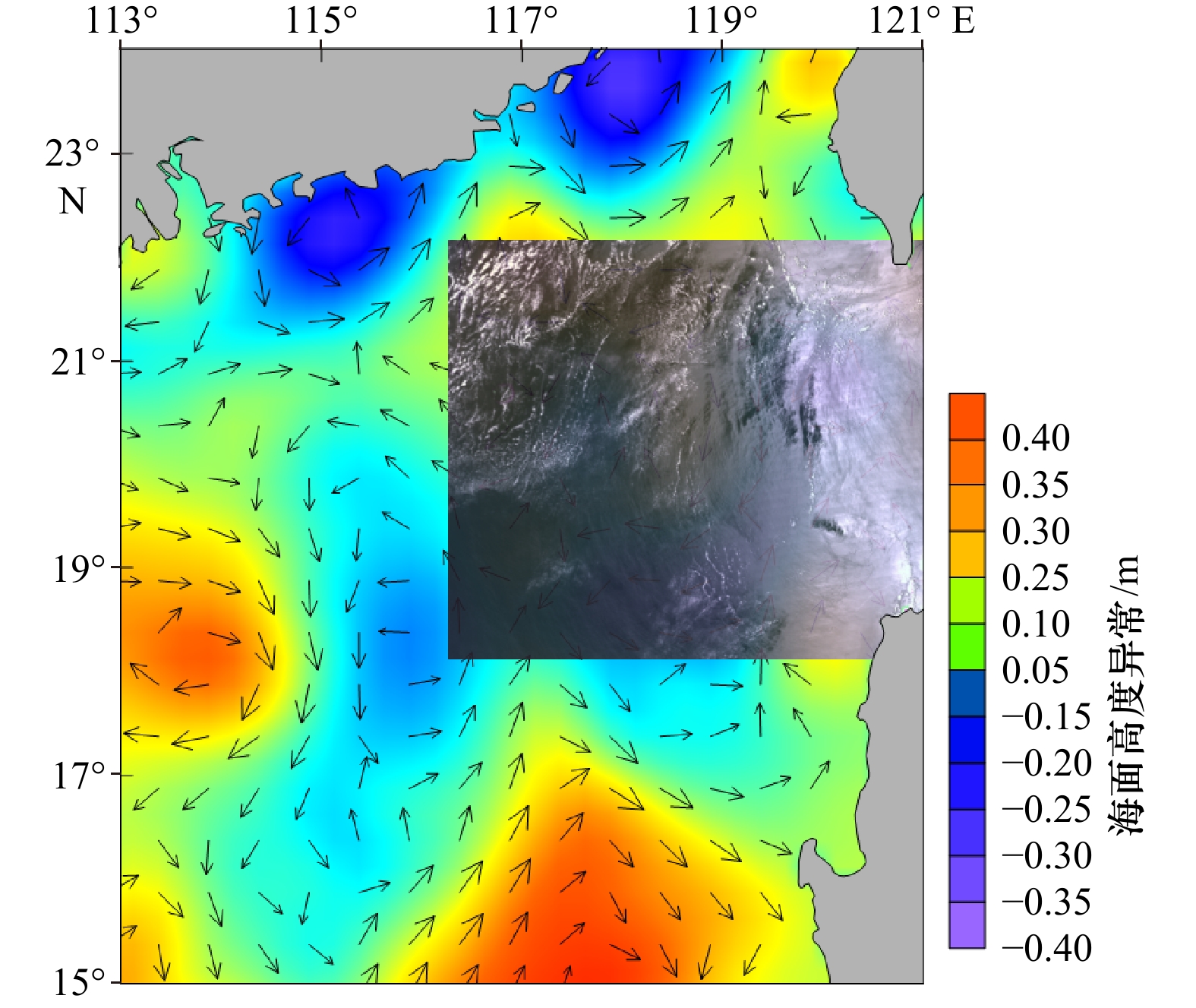Influence of mesoscale eddy on internal solitary wave propagation in the northern South China Sea based on remote sensing
-
摘要: 海洋内孤立波和中尺度涡是南海北部常见的中尺度动力过程。本文利用2010−2015年的Terra/Aqua-MODIS、ENVISAT ASAR和多源卫星高度计资料开展了南海海洋内孤立波和中尺度涡遥感探测研究,分析了中尺度涡对内孤立波传播方向的影响。结果表明,中尺度涡和内孤立波主要在南海东北部海域共存,当二者共存时,气旋(冷涡)促使内孤立波偏离原来的传播方向,向西偏南方向传播;反气旋(暖涡)促使内孤立波向西偏北方向传播,气旋与反气旋改变的内孤立波传播方向刚好相反。内孤立波和中尺度涡共存时间主要集中在3−9月,其中,3月受气旋和反气旋的共同作用,内孤立波传播方向几乎无变化;4月和5月,主要受气旋影响,内孤立波偏离原来传播方向向南传播;6−9月,主要受反气旋影响,内孤立波偏离原来的传播方向向北传播。本文利用遥感手段探索了海洋中尺度涡对内孤立波传播方向的影响,结果与现场观测结果一致。Abstract: The internal solitary wave and mesoscale eddy are common mesoscale dynamic processes in the northern South China Sea. In this paper, we use the Terra/Aqua-MODIS, ENVISAT ASAR and multi-source satellite altimeter data from 2010 to 2015 to realize remote sensing of isolated waves and mesoscale eddy in the South China Sea, and analyze the influence of mesoscale eddy on the propagation direction of internal solitary wave. The results show that the mesoscale eddy and the internal solitary wave coexist mainly in the northeastern part of the South China Sea. When the two coexisted, the cyclone (cold eddy) caused the internal solitary wave to deviate from the original propagation direction and propagation and spread to the west-south direction. The anticyclonic (warm eddy) causes the internal solitary wave to spread westward to the north, and the cyclone and the anticyclone change the direction of the internal solitary wave propagation is just opposite. The coexistence time of internal solitary wave and mesoscale eddy is mainly concentrated from March to September, and the propagation direction of internal solitary wave is almost unchanged in March due to the interaction of cyclone and anticyclone. In April and May, the internal solitary wave deviated from its original propagation direction and propagated southward mainly due to cyclone. From June to September, the internal solitary wave deviated from its original direction and propagated northward, mainly under the influence of anticyclone. In April and May, the internal solitary wave deviated from its original propagation direction and propagated southward mainly due to cyclone. From June to September, the internal solitary wave deviated from its original direction and propagated northward, mainly under the influence of anticyclone. The effect of mesoscale eddy on the propagation direction of internal solitary wave is investigated by remote sensing, and the results are in agreement with the field observation.
-
Key words:
- internal solitary wave /
- mesoscale eddy /
- remote sensing /
- northern South China Sea
-
图 1 南海中尺度涡和内孤立波空间分布
不同颜色的曲线代表不同年份的内孤立波波峰线;红色三角代表反气旋涡的中心位置;蓝色圆圈代表气旋涡的中心位置
Fig. 1 Spatial distribution of mesoscale eddy and internal solitary wave in the South China Sea
The curves with different colors represent the internal solitary wave peak lines in different years;the red triangles represent the center of anticyclone eddy; the blue circles represent the center of cyclone eddy
图 2 南海中尺度涡和内孤立波位置月分布
黑色曲线代表内孤立波波峰线;红色块代表反气旋涡的位置;蓝色块代表气旋涡的位置
Fig. 2 Monthly distribution of mesoscale eddy and internal solitary wave in the South China Sea
The black curve represents the internal solitary wave peak line;the red block represents the position of the anticyclone eddy; the blue block represents the position of the cyclone eddy
图 3 南海东北部中尺度涡和内孤立波传播方向示意图
黑色曲线代表内孤立波波峰线;红色块代表反气旋涡的位置;蓝色块代表气旋涡的位置
Fig. 3 Schematic diagram of mesoscale eddy and propagation direction of internal solitary wave in northeast South China Sea
The black curve represents the internal solitary wave peak line;the red block represents the position of the anticyclone eddy; the blue block represents the position of the cyclone eddy
-
[1] Hsu M K, Liu A K, Liu Cheng. A study of internal waves in the China seas and Yellow Sea using SAR[J]. Continental Shelf Research, 2000, 20(4/5): 389−410. [2] Ramp S R, Tang T Y, Duda T F, et al. Internal solitons in the northeastern South China Sea. Part I: sources and deep water propagation[J]. IEEE Journal of Oceanic Engineering, 2004, 29(4): 1157−1181. doi: 10.1109/JOE.2004.840839 [3] Alford M H, Lien R C, Simmons H, et al. Speed and evolution of nonlinear internal waves transiting the South China Sea[J]. Journal of Physical Oceanography, 2010, 40(6): 1338−1355. doi: 10.1175/2010JPO4388.1 [4] Huang Xiaodong, Zhao Wei, Tian Jiwei, et al. Mooring observations of internal solitary waves in the deep basin west of Luzon Strait[J]. Acta Oceanologica Sinica, 2014, 33(3): 82−89. doi: 10.1007/s13131-014-0416-7 [5] Huang Xiaodong, Chen Zhaohui, Zhao Wei, et al. An extreme internal solitary wave event observed in the northern South China Sea[J]. Scientific Reports, 2016, 6(1): 30041. doi: 10.1038/srep30041 [6] Zhao Zhongxiang, Liu Bingqing, Li Xiaofeng. Internal solitary waves in the China seas observed using satellite remote-sensing techniques: a review and perspectives[J]. International Journal of Remote Sensing, 2014, 35(11/12): 3926−3946. [7] 崔凤娟, 匡晓迪, 王玉, 等. 南海中尺度涡年际变化特征及动力机制分析[J]. 海洋与湖沼, 2015, 46(3): 508−516. doi: 10.11693/hyhz20140900242Cui Fengjuan, Kuang Xiaodi, Wang Yu, et al. The analysis on interannual variation characteristics of eddy activities and its dynamic mechanism in the South China Sea[J]. Oceanologia et Limnologia Sinica, 2015, 46(3): 508−516. doi: 10.11693/hyhz20140900242 [8] Chen Gengxin, Hou Yijun, Chu Xiaoqing. Mesoscale eddies in the South China Sea: mean properties, spatiotemporal variability, and impact on thermohaline structure[J]. Journal of Geophysical Research: Oceans, 2011, 116(C6): C06018. [9] Fu L L, Holt B. Some examples of detection of oceanic mesoscale eddies by the SEASAT synthetic-aperture radar[J]. Journal of Geophysical Research: Oceans, 1983, 88(C3): 1844−1852. doi: 10.1029/JC088iC03p01844 [10] Joyce T M, Stalcup M C. An upper ocean current jet and internal waves in a Gulf Stream warm core ring[J]. Journal of Geophysical Research: Oceans, 1984, 89(C2): 1997−2003. doi: 10.1029/JC089iC02p01997 [11] Alpers I, Holt B. Imaging of ocean features by SIR-C/X-SAR: an overview[C]//Proceedings of 1995 International Geoscience and Remote Sensing Symposium on Quantitative Remote Sensing for Science and Applications. Firenze, Italy: IEEE, 1995: 1588−1590. [12] Lyzenga D, Wackerman C. Detection and classification of ocean eddies using ERS-1 and aircraft SAR images[R]. Ann Arbor: ESA, 1997: 1267 [13] Kirby D S, Barton E D, Mitchelson-Jacob E G, et al. SAR remote sensing of wind-driven circulation in the Gulf of Tehuantepec, Mexico[C]//Proceedings of the 3rd ERS Symposium on Space at the service of our Environment. Florence, Italy: European Space Agency, 1997: 1273. [14] 司广成, 于非, 刁新源. 南海北部中尺度涡与内波相遇的特征分析[J]. 海洋科学, 2014, 38(7): 89−94. doi: 10.11759/hykx20121225001Si Guangcheng, Yu Fei, Diao Xinyuan. Characteristics of encounter between a mesoscale eddy and internal waves in the northern South China Sea[J]. Marine Sciences, 2014, 38(7): 89−94. doi: 10.11759/hykx20121225001 [15] Xie Jieshuo, He Yinghui, Chen Zhiwu, et al. Simulations of internal solitary wave interactions with mesoscale eddies in the northeastern South China Sea[J]. Journal of Physical Oceanography, 2015, 45(12): 2959−2978. doi: 10.1175/JPO-D-15-0029.1 [16] Park J H, Farmer D. Effects of Kuroshio intrusions on nonlinear internal waves in the South China Sea during winter[J]. Journal of Geophysical Research: Oceans, 2013, 118(12): 7081−7094. doi: 10.1002/2013JC008983 [17] Liao Guanghong, Yang Chenghao, Xu Xiaohua, et al. Effects of mesoscale eddies on the internal solitary wave propagation[J]. Acta Oceanologica Sinica, 2012, 31(5): 26−40. doi: 10.1007/s13131-012-0233-9 [18] Xie Jieshuo, He Yinghui, Lü Haibin, et al. Distortion and broadening of internal solitary wavefront in the northeastern South China Sea deep basin[J]. Geophysical Research Letters, 2016, 43(14): 7617−7624. doi: 10.1002/2016GL070093 [19] Li Qiang, Wang Bing, Chen Xu, et al. Variability of nonlinear internal waves in the South China Sea affected by the Kuroshio and Mesoscale eddies[J]. Journal of Geophysical Research: Oceans, 2016, 121(4): 2098−2118. doi: 10.1002/2015JC011134 [20] Huang Xiaodong, Zhang Zhiwei, Zhang Xiaojiang, et al. Impacts of a mesoscale eddy pair on internal solitary waves in the northern South China Sea revealed by mooring array observations[J]. Journal of Physical Oceanography, 2017, 47(7): 1539−1554. doi: 10.1175/JPO-D-16-0111.1 [21] Xu Jiexin, He Yinghui, Chen Zhiwu, et al. Observations of different effects of an anti-cyclonic eddy on internal solitary waves in the South China Sea[J]. Progress in Oceanography, 2020, 188: 102422. doi: 10.1016/j.pocean.2020.102422 [22] Hwang C, Chen S A. Circulations and eddies over the South China Sea derived from TOPEX/Poseidon altimetry[J]. Journal of Geophysical Research: Oceans, 2000, 105(C10): 23943−23965. doi: 10.1029/2000JC900092 [23] Wang Liping, Koblinsky C J, Howden S. Mesoscale variability in the South China Sea from the TOPEX/Poseidon altimetry data[J]. Deep-Sea Research Part I: Oceanographic Research Papers, 2000, 47(4): 681−708. doi: 10.1016/S0967-0637(99)00068-0 [24] 程旭华, 齐义泉, 王卫强. 南海中尺度涡的季节和年际变化特征分析[J]. 热带海洋学报, 2005, 24(4): 51−59. doi: 10.3969/j.issn.1009-5470.2005.04.008Cheng Xuhua, Qi Yiquan, Wang Weiqiang. Seasonal and interannual variabilities of mesoscale eddies in South China Sea[J]. Journal of Tropical Oceanography, 2005, 24(4): 51−59. doi: 10.3969/j.issn.1009-5470.2005.04.008 [25] 林鹏飞, 王凡, 陈永利, 等. 南海中尺度涡的时空变化规律Ⅰ. 统计特征分析[J]. 海洋学报, 2007, 29(3): 14−22.Lin Pengfei, Wang Fan, Chen Yongli, et al. Temporal and spatial variation characteristics on eddies in the South China SeaⅠ. Statistical analyses[J]. Haiyang Xuebao, 2007, 29(3): 14−22. [26] Alford M H, Peacock T, MacKinnon J A, et al. The formation and fate of internal waves in the South China Sea[J]. Nature, 2015, 521(7550): 65−69. doi: 10.1038/nature14399 -





 下载:
下载:




